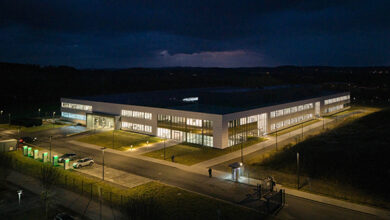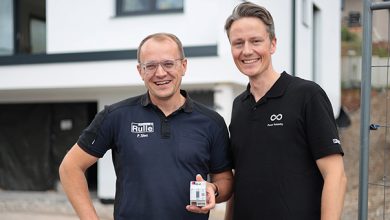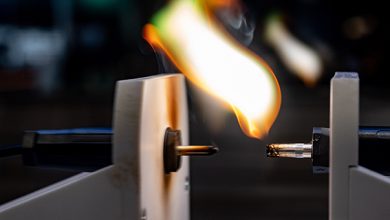No matter how many advantages direct current has on its side – there are still massive reservations about using DC, even in specialist circles. And far too few experts who not only plan, but also install. Bernd Zeilmann is one of these rare specimens.

Bernd Zeilmann now knows the way to Blomberg almost in his sleep. The head foreman of the Bayreuth Electrical Guild is one of the people responsible for implementing the DC factory on Flachsmarktstrasse. Whether trade, industry or research – Bernd Zeilmann is at home everywhere and knows exactly what works and where there are difficulties when it comes to direct current.
What drives a trained electrician and master craftsman from a traditional trade business to venture into such an innovative field as DC technology? You can immediately tell that Master Craftsman Zeilmann is passionate about innovation: “My goal is to maintain and improve the high quality of our work in the guild trade. That explains my interest in innovation and research. That’s how I became aware of the concept of the All Electric Society, which could be one way of implementing the necessary energy transition.
At Richter R&W , we have always built switching devices and developed automation solutions for the machine building industry, which has a strong presence in our region, and have also worked with software and control systems. With the topic of innovative energy distribution based on direct current, we are expanding our customer base and supporting municipal and commercial customers on their way to climate neutrality.” With this in mind, Zeilmann and his colleagues at the Bayreuth guild have sought an exchange with the Fraunhofer Institute IISB in Erlangen to jointly develop solutions for the energy transition. The practitioners wanted and want to speed up technology development, from prototypes to demonstrators to series production. Because, according to Bernd Zeilmann: “We are not competing nationally, but globally.”
It soon became clear just how complex this project can be. A good eight years ago, the Fraunhofer Institute in Erlangen wanted to set up the first research DC microgrid. But even the renowned institute was initially unable to find a specialist company that could set up such a DC network. Richter R&W took part in the tender and was promptly awarded the contract for the DC power distribution. The clever Zeilmann immediately thought ahead and installed an innovative DC microgrid in his own company.
Link to the industry
In addition to planning and installing the DC grid in the All Electric Society Factory of Phoenix Contact, the experts from Franconian Switzerland were also recently deployed for the “NExT Factory” of DC pioneer Schaltbau from Munich. And the number of innovative projects is increasing: “We are currently testing bidirectional charging with a mobile DC grid housed in a container for the Federal Ministry for Digital and Transport.”
Phoenix Contact and Schaltbau are now partner companies when it comes to direct current. And Bernd Zeilmann is the practitioner and implementer, the link between the companies, so to speak. “Today, we can offer direct current networks that are largely based on components from Phoenix Contact and Schaltbau.”
However, the road to their own direct current grid is still a rocky one. Bernd Zeilmann explains why: “A major sticking point is the regulations and standards according to which such energy grids have to be set up. It is of course valuable for us that I myself am involved in the standardization committees of the relevant standardization bodies. This allows us to directly contribute our experience from the projects and advance innovative topics such as bidirectional charging and DC microgrids.”
The innovative Zeilmann, who represents the Zentralverband der Deutschen Elektro- und Informationstechnischen Handwerke (ZVEH) in his committee work, discusses how the energy transition can be realized with scientists and political decision-makers, grid operators and industry. “A complex topic,” explains the Franconian. “You’re linking the electricity sector with the transport and heating sectors, and these interfaces didn’t exist on this scale before. This is new territory.”
Bernd Zeilmann contributes the vision of sector coupling from his own experience: “I have been driving electrically for many years. My grid operator can tell me which charging station to connect where. But they are not at all interested in the car that is then charging. If I want to connect a stationary battery storage system to the grid, I have to register it and get it approved. But what if the car can function as a mobile battery storage system thanks to bidirectional charging?
Independent island
We have solved this problem by using the certified power control unit from Phoenix Contact, which ensures access to the AC grid in the medium-voltage range. Since the beginning of 2024, operators of controllable equipment have been free to decide whether to operate their DC microgrid downstream of the connection point to the public grid under their own responsibility or to allow the grid operator to intervene via direct control. After all, it is not acceptable for a grid operator to down-regulate customer systems even though the customer has a demand for their own electricity. These are new solutions that are really in demand at the moment.”
In Zeilmann’s view, this personal responsibility makes sense. “Industrial plants need a lot of electricity. And connections to the medium-voltage grid are extremely expensive. So the idea is to go to the low-voltage grid and cushion possible peak loads in production with battery storage systems and self-generation of electricity with a DC microgrid. Schaltbau’s ‘NExT Factory’ assumes a 70 percent lower connected load. They have a high-bay warehouse that runs on a DC microgrid. Recuperation and battery storage systems save a large part of the connected load.”
The construction of industrial direct current grids has an important economic policy aspect: “The average industrial electricity price is currently around 20 to 30 cents per kilowatt hour. Electricity that is produced in-house only costs the one-off investment in technology and ongoing maintenance. That works out at around 6 to 8 cents per kWh. And we’re all talking about subsidies for industrial electricity for German industry? The solution lies in a combination of self-generation and purchasing with a dynamic electricity price!”
Brake skilled worker
The opportunities seem huge. But are there also obstacles on the way to the perfect energy transition? Zeilmann sighs: “Clearly the shortage of skilled workers. What use is the best component to the industry if nobody can install it? Even when it comes to heat pumps or electric cars, we should be glad that the big boom hasn’t happened yet. We don’t have the experts to be active everywhere. The electrical companies in the guilds are all working at 100 percent capacity. It’s not for nothing that Asian groups, for example, are now starting to buy up German trade businesses.”

That’s why Bernd Zeilmann has a clear message for the industry: “Due to the shortage of skilled workers, we have to prefabricate automatically. The days when we could wire distribution boards on site by hand are over. We can no longer manage that in terms of personnel if we want to maintain a high level of quality.”
Since Hannover Messe 2025, Richter R&W has been an official solution partner of Phoenix Contact. This underlines how fruitful cooperation between industry and trade can be. A partnership at eye level …










